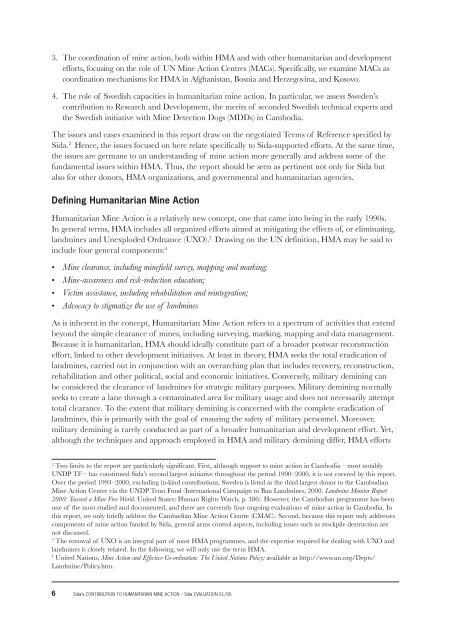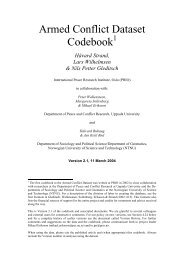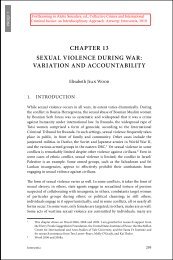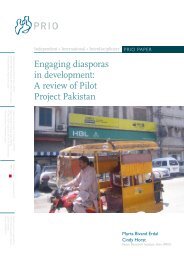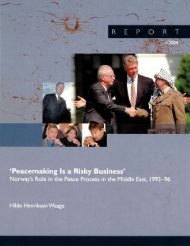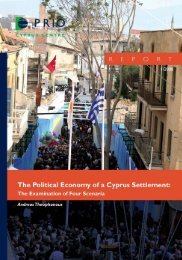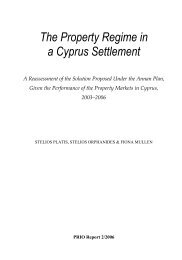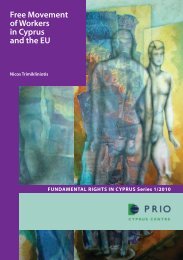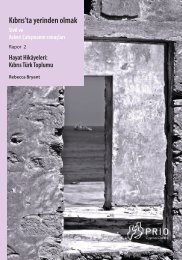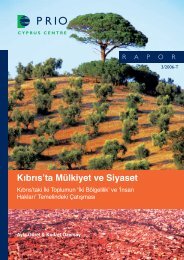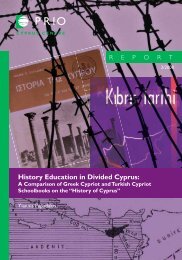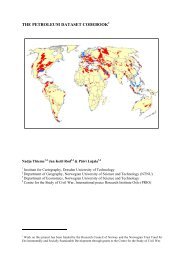3. The coordination of mine action, both within HMA and with other humanitarian and developmentefforts, focusing on the role of UN <strong>Mine</strong> <strong>Action</strong> Centres (MACs). Specifically, we examine MACs ascoordination mechanisms for HMA in Afghanistan, Bosnia and Herzegovina, and Kosovo.4. The role of Swedish capacities in humanitarian mine action. In particular, we assess Sweden’scontribution <strong>to</strong> Research and Development, the merits of seconded Swedish technical experts andthe Swedish initiative with <strong>Mine</strong> Detection Dogs (MDDs) in Cambodia.The issues and cases examined in this report draw on the negotiated Terms of Reference specified bySida. 2 Hence, the issues focused on here relate specifically <strong>to</strong> Sida-supported efforts. At the same time,the issues are germane <strong>to</strong> an understanding of mine action more generally and address some of thefundamental issues within HMA. Thus, the report should be seen as pertinent not only for Sida butalso for other donors, HMA organizations, and governmental and humanitarian agencies.Defining <strong>Humanitarian</strong> <strong>Mine</strong> <strong>Action</strong><strong>Humanitarian</strong> <strong>Mine</strong> <strong>Action</strong> is a relatively new concept, one that came in<strong>to</strong> being in the early 1990s.In general terms, HMA includes all organized efforts aimed at mitigating the effects of, or eliminating,landmines and Unexploded Ordnance (UXO). 3 Drawing on the UN definition, HMA may be said <strong>to</strong>include four general components: 4• <strong>Mine</strong> clearance, including minefield survey, mapping and marking;• <strong>Mine</strong>-awareness and risk-reduction education;• Victim assistance, including rehabilitation and reintegration;• Advocacy <strong>to</strong> stigmatize the use of landminesAs is inherent in the concept, <strong>Humanitarian</strong> <strong>Mine</strong> <strong>Action</strong> refers <strong>to</strong> a spectrum of activities that extendbeyond the simple clearance of mines, including surveying, marking, mapping and data management.Because it is humanitarian, HMA should ideally constitute part of a broader postwar reconstructioneffort, linked <strong>to</strong> other development initiatives. At least in theory, HMA seeks the <strong>to</strong>tal eradication oflandmines, carried out in conjunction with an overarching plan that includes recovery, reconstruction,rehabilitation and other political, social and economic initiatives. Conversely, military demining canbe considered the clearance of landmines for strategic military purposes. Military demining normallyseeks <strong>to</strong> create a lane through a contaminated area for military usage and does not necessarily attempt<strong>to</strong>tal clearance. To the extent that military demining is concerned with the complete eradication oflandmines, this is primarily with the goal of ensuring the safety of military personnel. Moreover,military demining is rarely conducted as part of a broader humanitarian and development effort. Yet,although the techniques and approach employed in HMA and military demining differ, HMA efforts2Two limits <strong>to</strong> the report are particularly significant. First, although support <strong>to</strong> mine action in Cambodia – most notablyUNDP TF – has constituted Sida’s second largest initiative throughout the period 1990–2000, it is not covered by this report.Over the period 1993–2000, excluding in-kind contributions, Sweden is listed as the third largest donor <strong>to</strong> the Cambodian<strong>Mine</strong> <strong>Action</strong> Centre via the UNDP Trust Fund (International Campaign <strong>to</strong> Ban Landmines, 2000. Landmine Moni<strong>to</strong>r Report2000: Toward a <strong>Mine</strong> Free World. United States: Human Rights Watch, p. 386). However, the Cambodian programme has beenone of the most studied and documented, and there are currently four ongoing evaluations of mine action in Cambodia. Inthis report, we only briefly address the Cambodian <strong>Mine</strong> <strong>Action</strong> Centre (CMAC). Second, because this report only addressescomponents of mine action funded by Sida, general arms control aspects, including issues such as s<strong>to</strong>ckpile destruction arenot discussed.3The removal of UXO is an integral part of most HMA programmes, and the expertise required for dealing with UXO andlandmines is closely related. In the following, we will only use the term HMA.4United Nations, <strong>Mine</strong> <strong>Action</strong> and Effective Co-ordination: The United Nations Policy; available at http://www.un.org/Depts/Landmine/Policy.htm.6 Sida’s CONTRIBUTION TO HUMANITARIAN MINE ACTION – Sida EVALUATION 01/06
frequently draw on personnel and techniques adopted from the military. From a humanitarian perspective,this is often quite problematic. Since the goal of military clearance is <strong>to</strong> secure strategic areas or <strong>to</strong>create a passage primarily for military purposes, 5 and since – in contrast with HMA – military mineclearance does not aim at <strong>to</strong>tal eradication of landmines or the return of areas <strong>to</strong> local communities,mine action becomes divorced from other humanitarian endeavours, falling victim <strong>to</strong> a myopic approachthat focuses almost exclusively on technical issues. This is a dilemma for HMA that we willreturn <strong>to</strong> throughout this report.The context for <strong>Humanitarian</strong> <strong>Mine</strong> <strong>Action</strong>One of the fundamental considerations guiding this report is an examination of the context in whichHMA takes place. As an obvious statement, different countries are characterized by unique social,political and his<strong>to</strong>rical circumstances. Such contextual fac<strong>to</strong>rs can be seen as determining the range ofoptions available in a country, serving either as facilita<strong>to</strong>rs or as constric<strong>to</strong>rs for mine action. From theperspective of HMA, one of the most important fac<strong>to</strong>rs is where a country falls on the ‘emergency–development continuum’. Whether a country is in a complex state of emergency, such as war, or is inthe process of initiating redevelopment can be seen as a determining fac<strong>to</strong>r in assessing the appropriatemine-action response. The political environment, including fac<strong>to</strong>rs such as regime stability and institutionalresponsiveness, can also affect HMA responses. Existing capacities in terms of knowledge,resources and organizational strength further determine the suitability of different approaches <strong>to</strong> mineaction. Logistical fac<strong>to</strong>rs such as geography, roads and climate are important in deciding on an approach.Last but not least, the scope of the mine problem is also a key aspect, not necessarily in termsof numbers, but in terms of the threat landmines pose and whether the extent of that threat can bedetermined. In the subsequent chapters of this report, we sketch out the relevant contextual fac<strong>to</strong>rs asthey apply <strong>to</strong> the cases in question here, with the goal of developing an understanding of how theseaffect HMA practices (see Appendix 1.4).The Sida responseIn addition <strong>to</strong> an examination of context, a point of reference throughout this report is that of Sida’sguiding principles and practices on HMA. While Sida’s country-specific practices will be detailed in thecoming chapters, it is useful at this juncture <strong>to</strong> gain an understanding of Sida’s general mine-actionguidelines (see Figure 1.1).As a general rule, Sida’s contributions <strong>to</strong> HMA have not been guided by any coherent policy position,and there has been no formal decision mandating Sida involvement in mine action. Sida has escheweda ‘blueprint’ policy solution, preferring <strong>to</strong> assess the merits of different funding channels. Decisionmakinghas been on a year-by-year basis, and there is no allocation of funds specifically for HMA. Responsibilityis divided in<strong>to</strong> regional or thematic areas; decisions are taken based on the needs of eachcountry or region; and these decisions dictate <strong>to</strong>tal expenditures. As a result, the amount of funding formine action provided by Sida each year varies greatly. Funding <strong>to</strong> mine action is prioritized in thecontext of other pertinent issues in a country – e.g., natural disasters, emergencies, etc. – and, if HMAis viewed as important in relation <strong>to</strong> these issues, it will receive funding.In spite of the lack of an overarching policy, it is possible <strong>to</strong> identify a number of principles that haveguided Sida decisionmaking. The most basic tenet of Sida’s support <strong>to</strong> mine action is that of humanitari-5Chris Horwood, 2000. ‘<strong>Humanitarian</strong> <strong>Mine</strong> <strong>Action</strong>: The First Decade of a New Sec<strong>to</strong>r in <strong>Humanitarian</strong> Aid’, Relief andRehabilitation Network Papers 32. London: Overseas Development Institute, p. 9.Sida’s CONTRIBUTION TO HUMANITARIAN MINE ACTION – Sida EVALUATION 01/06 7
- Page 4: This report is part of Sida Evaluat
- Page 9 and 10: MDDMEDDSMGMMLSWMoPHMOUMPLANATONDING
- Page 12 and 13: the conclusions of this report is t
- Page 14 and 15: A prime concern with Mine Action Ce
- Page 18 and 19: an needs and the needs of victims o
- Page 20 and 21: At the same time as Sida has been o
- Page 22 and 23: er, throughout the data collection,
- Page 24 and 25: Donors may feel that the costs of i
- Page 26 and 27: is genuinely new. 8 At an overall l
- Page 28 and 29: The first attempt to apply a form o
- Page 30 and 31: standard for basic impact surveys.
- Page 32 and 33: Community studiesCommunity studies
- Page 34 and 35: and progress monitored in all phase
- Page 36 and 37: 3 Implementation ChannelsOver the p
- Page 38 and 39: cal implementation and management,
- Page 40 and 41: ing that demining has any effect at
- Page 42 and 43: actual response. In an effort to ov
- Page 44 and 45: ecently developed. The approaches t
- Page 46 and 47: A different tool that will be used
- Page 48 and 49: Alternative implementation channels
- Page 50 and 51: appear to have been doing a good jo
- Page 52 and 53: Coordination may at times even be c
- Page 54 and 55: itarian and development effort. Imp
- Page 56 and 57: Two). In terms of coordinating mine
- Page 58 and 59: ased demining of AREA. Another type
- Page 60 and 61: The Kosovo UNMACC took a number of
- Page 62 and 63: would be accredited and tasked by U
- Page 64 and 65: programme. The proposal was backed
- Page 66 and 67:
The present landscape of Swedish ac
- Page 68 and 69:
demining purposes. Buoyed by a wave
- Page 70 and 71:
given that SRSA also recruits perso
- Page 72 and 73:
teams. The need for a breeding capa
- Page 74 and 75:
6 RecommendationsIn the preceding c
- Page 76 and 77:
• MACs should operate with agreem
- Page 78 and 79:
7 ConclusionIn this report, we have
- Page 80:
70Appendix 1
- Page 89 and 90:
Ziauddin Operations Officer METADup
- Page 91 and 92:
Bennedich, Claes Department for eva
- Page 93 and 94:
Appendix 3BIBLIOGRAPHYAccelerated D
- Page 95 and 96:
Faulkner, F. & L Pettiford, 1998.
- Page 97 and 98:
McGrath, Rae, 2000. Landmines and U
- Page 99 and 100:
Miscellaneous DocumentsBrady, Justi
- Page 101 and 102:
Appendix 4Sida’s CONTRIBUTION TO
- Page 103 and 104:
Appendix 6• The area must be secu
- Page 105 and 106:
Appendix 7Locality identifier: Dist
- Page 107:
Recent Sida Evaluations00/37:1 Asse


